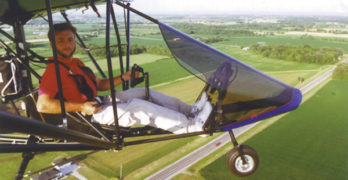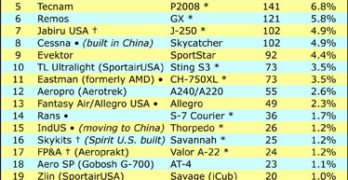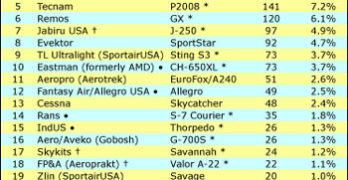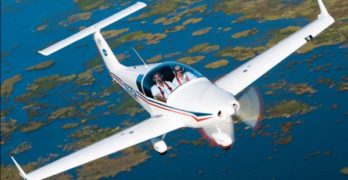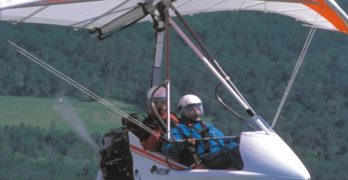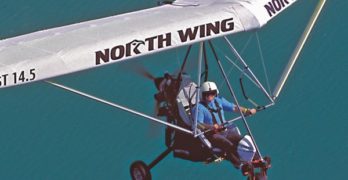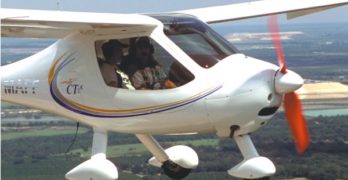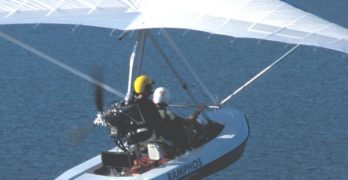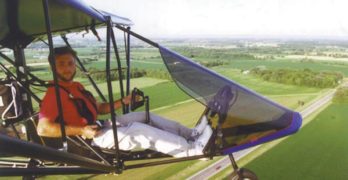[UPDATE spring 2014] — The Aerolite 103 is now manufacturered in Deland, Florida by U-Fly-It, the contact info for which is located at the end of this article. In addition, a new company is representing the product in Europe under the name Vierwerk. The design appears to be enjoying great interest and support at this time.
[UPDATE summer 2011] — Aero-Works, the company referred to in this article written in 1997, left the business several years ago. During its absence a different producer, Wings of Freedom, offered their Phoenix-103, a derivation of the Aero-Lite 103 but with numerous small changes.
This article refers to the aircraft built by AeroWorks and will not be identical to the Aero-Lite 103. The companies are different and Terry Raber has no association with Wings of Freedom.
Now, in the summer of 2011, I am happy to report the original designer is again the producer of the Aerolite 103, and it retains an excellent price, less than $15,000.
Search Results for : risen
Not finding exactly what you expected? Try our advanced search option.
Select a manufacturer to go straight to all our content about that manufacturer.
Select an aircraft model to go straight to all our content about that model.
First Half 2011 LSA Market Report
Several readers have asked and we are finally delivering. Jan Fridrich and I present the LSA Market Share Report for the first half of 2011. Figures show a mimicking of 2010 output and that was not a strong year. However, the numbers are not down from 2010 so you could see stability if not growth. *** In the first half of 2011 six companies account for almost 90% of registrations and Cessna alone accounted for precisely half of these. The other five producers: CubCrafters (17% of all first half 2011 deliveries), Czech Aircraft Works (including PiperSport, 13%), Flight Design (7%), Jabiru (4%), and Aerotrek (3%). *** The Over-100 Club now has eight members (chart) up from six at the end of 2010. Our numbers reflect total fleet size, so growth measured this way is inevitable. This method of illustrating market share identifies the strongest producers since 2005.
Irony in 2010 Market Share Report
You just have to marvel how a dynamic new industry unfolds. No matter your level of expertise — in or out of government, large or small private organization, or even as an individual guru — no one can exactly foretell the future of the grand experiment we call Light-Sport aviation. *** So, what’s the irony? After all the years I’ve released the results of Jan Fridrich’s laborious market share assessments using FAA data, one company has finally displaced perpetual #2 producer, American Legend. The star that rose is, of course, Piper, who not quite one year ago announced they would distribute the then-Sport Cruiser. That model (with its own winding tale) had done respectably well on its own and Piper’s legacy brand brought an impressive growth spurt even during a very weak economy. Yet, even as Piper rose from 6th place last year to dislodge the Legend Cub producer, the Vero Beach outfit ended their relationship with Czech Sport Aircraft.
Canadian-Designed Czech-Built Skylark
A Doubly International LSA
SportsPlanes.com imports several
light-sport aircraft (LSA)
that have found ready buyers.
After researching through
several designs, SportsPlanes’ owner
Josh Foss originally settled on the
Comco Ikarus C42 and Breezer and
the U.S.-built American Flyer for its
fleet. Most recently, the company
added the Czech-built Dova Skylark
to its offerings.
However, the real story of this company
is not Josh Foss’ care in the selection
of what airplanes to sell. What
may be more important to the marketplace
is the network his company
has built to bring service and support
to SportsPlanes.com’s customers.
Currently, 15 SportsPlanes centers are
operating, with the goal to establish
25 centers nationwide.
Investigating the Skylark
My opportunity to fly the Skylark
came while attending the U.S. Sport
Aviation Expo in Sebring, Florida, in
January. I flew with Darrell Hamilton,
the SportsPlanes representative
for Florida.
Darrell retired from Northwest
Airlines four years ago. He most recently
crewed the fly-by-wire Airbus
A320, which needs only small control
movements.
GT Ultralights: A Versatile Trike Supplier
Ukrainian airframe producer Aeros has risen from complete obscurity in the early 1990s (after the Berlin Wall fell) to wide recognition in recreational aviation. Although powered ultralight and light-sport aircraft enthusiasts may not immediately know the brand, hang glider pilots around the world are very aware of the name. The current reigning world champion hang glider pilot is Oleg Bondarchuck, a Ukrainian pilot who works with Aeros.
This young company emerging from the former Soviet mantel also makes an ultralight sailplane plus two powered aircraft. Aeros produces the Sky Ranger 3-axis airplane (under agreement with its French designer), and it has designed and markets its own trike. The company also supplies trike wings for other producers like Antares. By any normal measurements, Aeros is a versatile company.
Many ultralight and LSA pilots probably know the Aeros Velocity trike, and may recall its earlier name, Venture. In those days, it was sold by Sabre Aircraft alongside the trikes that Arizona company made here in America.
Co-Developing the Navajo Trike
A couple of years ago, TC’s Trikes owner TC Blyth and North Wing owner Kamron Blevins joined forces in a cooperative arrangement. TC’s Trikes would buy wings from North Wing (rather than continue to make their own), and could better represent North Wing on the Eastern Seaboard. North Wing, headquartered in the northwestern state of Washington, is far from TC’s Trikes’ Tennessee home. It seemed a marriage of convenience and more.
Blyth has been particularly active in training and introductory flight lessons. He’s done many thousands of them at his location near a top Tennessee tourist and outdoorsmen attraction – the Ocoee River, popular for white water rafting, kayaking, and other sports. Blyth has been focused on meeting this need with his own brand of trikes, and all his experience gave him something clear and viable to add to the expertise of North Wing.
North Wing has risen to the top of the U.S.
Composite Two-seater (CT)
In the fall of ’01, I wrote in Ultralight Flying!, “The CT is the tip of an iceberg, in my opinion.” When I flew that first CT in the USA, few Yankees had seen the aircraft. I felt the German design represented the beginning of a flow of European aircraft coming to America. What a difference a couple of years make!
Thanks to adept and steady promotion, Americans may best identify the coming breed of proposed Light-Sport Aircraft by pointing to the Flight Design CT2K. While this means no disrespect to trikes, tube-and-rag ultralights, or powered parachutes, the CT’s unusual, smoothly-contoured shape is now well known to many Americans. Though the brand is fabricated in the Ukraine and assembled in Germany, it crosses the Atlantic as a prototypical candidate for FAA’s proposed Light-Sport Aircraft category.
Rollison Light Sport Aircraft imported the first U.S.-based CT I flew. The design is now brought in by Flightstar Sportplanes and HPower HKS engine honcho Tom Peghiny.
Italy’s Ramphos Flying Boat
Making a Splash
Last year as the flying season began, an unusual flying boat appeared at airshows. The machine was called Ramphos (pronounced RAM-fohss) and it featured a form of ducted prop surrounding a pair of counter-rotating blades. While these two components commanded a lot of attention, they were de-emphasized when the 2004 season arrived.
In 2003, the presentation was market-savvy. By showing a somewhat radical version of the familiar flying boat design – we’ve seen a few of these configurations over the years – the Ramphos attracted attention in a crowded marketplace. When you’re new (to the American public), you need some way to stand out from the crowd.
However, the downside of new, potentially radical ideas is that people – like me – tend to wait until the new concepts prove themselves. So I didn’t fly the Ramphos in 2003. That changed for 2004.
Modern Machine
For the 2004 flying season, the emphasis had been taken off the counter-rotating props, though it was still displayed and remains an option.
Aero-Lite 103
Manufacturers in the ultralight industry believe they know what pilots want or what they will buy, anyway. A 2-seater is usually part of the answer. But, in fact, many industry watchers are wrong.
While many observers make the statement, ÒNinety percent of ultralights are 2-seaters,Ó statistics tell another story. Nearly 40% of ultralight and microlight aircraft sold in the U.S. are single-seaters, according to Ultralight Flying! magazineÕs surveys of manufacturers. Despite the polling results, however, those experts have a point. Two-seaters do represent the majority of ultralights and microlights sold.
Yet, just when you think 2-seaters are going to take over the whole market, along comes a new trend. Maybe it was FAAÕs lack of action on Part 103 changes, or maybe manufacturers simply decided to take on the challenge of staying within 103Õs tight weight, speed and fuel quantity restrictions. Whatever the correct answer, it doesnÕt change the fact of a growing population of Part 103 ultralights.
- « Previous Page
- 1
- …
- 3
- 4
- 5


